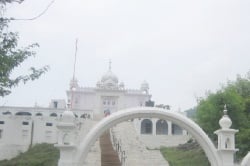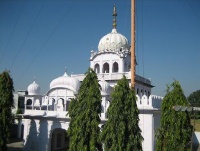Mata Jito: Difference between revisions
No edit summary |
Allenwalla (talk | contribs) m (typos and grammar) |
||
| Line 18: | Line 18: | ||
|} | |} | ||
'''Mata Jito, also called Mata Jeet kaur''' was first wife of [[Guru Gobind Singh]] Ji. She was the daughter of [[Bhai Harijas]], a Subhikkhi Khatri of Lahore. The betrothal had taken place in 1673. The father-in-law had desired that the bridegroom should come at the head of a marriage party to Lahore where the ceremony should be performed with due dignity. | '''Mata Jito, who was also called Mata Jeet kaur''' was the first wife of [[Guru Gobind Singh]] Ji. She was the daughter of [[Bhai Harijas]], a Subhikkhi Khatri of Lahore. The betrothal had taken place in 1673. The father-in-law had desired that the bridegroom should come at the head of a marriage party to Lahore where the ceremony should be performed with due dignity. | ||
The fateful events leading to the martyrdom of [[Guru Tegh Bahadur]] intervened, and in the changed circumstances it was not possible for the young Guru to go to [[Lahore]]. Therefore a temporary encampment was raised near the village of Basantgarh, 10 km north of [[Anandpur]], and named [[Guru]] ka Lahore where the nuptials were held on 23 Har 1734 Bk/21 June 1677. | The fateful events leading to the martyrdom of [[Guru Tegh Bahadur]] intervened, and in the changed circumstances it was not possible for the young Guru to go to [[Lahore]]. Therefore a temporary encampment was raised near the village of Basantgarh, 10 km north of [[Anandpur]], and named [[Guru]] ka Lahore where the nuptials were held on 23 Har 1734 Bk/21 June 1677. | ||
On 30th March 1699, Guru Gobind Singh created Khalsa at Anandpur. He declared that this Khalsa will be both Saints as well as Soldiers. When Gobind Singh was preparing amrit (nectar) for initiating the [[Khalsa]], on this occasion , stirring clean water in an iron bowl with a [[Khanda]] or double-edged sword, Mata Jitoji, as the tradition goes, came with sugar crystals which were dropped into the vessel at the Guru's bidding. Sweetness was thus added to the alchemy of steel. Mata Jito ji was the first Khalsa Woman. | On 30th March 1699, Guru Gobind Singh created the Khalsa at Anandpur. He declared that this Khalsa will be both Saints as well as Soldiers. When Gobind Singh was preparing amrit (nectar) for initiating the [[Khalsa]], on this occasion , stirring clean water in an iron bowl with a [[Khanda]] or double-edged sword, Mata Jitoji, as the tradition goes, came with sugar crystals which were dropped into the vessel at the Guru's bidding. Sweetness was thus added to the alchemy of steel. Mata Jito ji was the first Khalsa Woman. | ||
Three sons were born to Mata Jito ji — Jujhar Singh (14March 1691), Zorawar Singh (17 November 1696) and Fateh Singh (25 February 1699). Mata Jito Ji raised her three sons on the martyrdom tales of their grandfather Guru Tegh Bahadur and great great grandfather [[Guru Arjan Dev]] ji. She told them a Sikh never runs from a battle field. It was because of her teachings that all her three sons attained Martyrdom [[Jujhar Singh]] when was only 15 years old fighting with [[Mughal]]s at Chamkaur, [[Zorawar Singh]] and [[Fateh Singh]] who were only 9 and 6 years old at the hands of Wazir Khan, Mughal Governor of [[Sirhind]], when the young Sahibzades would not convert to Islam. | Three sons were born to Mata Jito ji — Jujhar Singh (14March 1691), Zorawar Singh (17 November 1696) and Fateh Singh (25 February 1699). Mata Jito Ji raised her three sons on the martyrdom tales of their grandfather Guru Tegh Bahadur and great great grandfather [[Guru Arjan Dev]] ji. She told them a Sikh never runs from a battle field. It was because of her teachings that all her three sons attained Martyrdom [[Jujhar Singh]] when was only 15 years old fighting with [[Mughal]]s at Chamkaur, [[Zorawar Singh]] and [[Fateh Singh]] who were only 9 and 6 years old at the hands of Wazir Khan, Mughal Governor of [[Sirhind]], when the young Sahibzades would not convert to Islam. | ||
| Line 29: | Line 29: | ||
==Claims by Modern Sikhs== | ==Claims by Modern Sikhs== | ||
Modern Scholars | Modern Scholars claim that Guru Gobind Singh had only one marriage and that Mata Jito and Mata sundari were indeed the same person. They explain that Mata Gujar Kaur was also known by the name Sundari as she was very beautiful and this was tradition of punjab? | ||
The sources which | The sources which infer that Mata Jito and Mata Sundri were separate personalities are the ''[[Gur Partap Suraj Granth]]'' by [[Bhai Santokh Singh]], the ''[[Twarikh Guru khalsa]]'', by [[Giani Gian Singh]], the ''Bansavalinama Dasan patshahiyan Ka'', by [[Kesar Singh Chibber]], the ''[[Mahankosh]]'', by [[Kahn Singh Nabha]] and the Encyclopedia of Sikhism'', by Harbas Singh of Patiala University. In addition to this there is a memorial related to the marriage at | ||
Guru ka Lahore and another memorial Related to Death at Anandpur. | |||
This begs the question, if there was only one wife then why did so many great Punjab historians not write these facts, or should we say, why were they so unaware of punjabi culture? Is it possible that they wrote huge granths and don't know about punjabi culture? | |||
[[Image:Gurudwara_Mata_jito_ji.jpg|thumb|right|200px|Place where last rites were performed]] | [[Image:Gurudwara_Mata_jito_ji.jpg|thumb|right|200px|Place where last rites were performed]] | ||
There's gurdwara sahib called Gurdwara mata Jito Ji at anandpur where last rites of mata ji | There's gurdwara sahib called Gurdwara mata Jito Ji at anandpur where last rites of mata ji were performed and Mata sahib Kaur ji last rites were performed at Gurdwara bala Sahib Delhi. Mata Sundri's last rights were also performed in Delhi. | ||
==References== | ==References== | ||
Revision as of 10:07, 30 April 2010
| Mata Ajeet Kaur | |
| Full Name : | Ajeet Kaur, Jeeto, Jito |
| Birth : | 1673, Lahore |
| Parents : | Bhai Harjas |
| Spouse : | Guru Gobind Singh |
| Children : | Ajit Singh, Jujhar Singh, Zorawar Singh, Fateh Singh |
| Death : | 5 Dec, 1700, Anandpur Sahib |
Mata Jito, who was also called Mata Jeet kaur was the first wife of Guru Gobind Singh Ji. She was the daughter of Bhai Harijas, a Subhikkhi Khatri of Lahore. The betrothal had taken place in 1673. The father-in-law had desired that the bridegroom should come at the head of a marriage party to Lahore where the ceremony should be performed with due dignity.
The fateful events leading to the martyrdom of Guru Tegh Bahadur intervened, and in the changed circumstances it was not possible for the young Guru to go to Lahore. Therefore a temporary encampment was raised near the village of Basantgarh, 10 km north of Anandpur, and named Guru ka Lahore where the nuptials were held on 23 Har 1734 Bk/21 June 1677.
On 30th March 1699, Guru Gobind Singh created the Khalsa at Anandpur. He declared that this Khalsa will be both Saints as well as Soldiers. When Gobind Singh was preparing amrit (nectar) for initiating the Khalsa, on this occasion , stirring clean water in an iron bowl with a Khanda or double-edged sword, Mata Jitoji, as the tradition goes, came with sugar crystals which were dropped into the vessel at the Guru's bidding. Sweetness was thus added to the alchemy of steel. Mata Jito ji was the first Khalsa Woman.
Three sons were born to Mata Jito ji — Jujhar Singh (14March 1691), Zorawar Singh (17 November 1696) and Fateh Singh (25 February 1699). Mata Jito Ji raised her three sons on the martyrdom tales of their grandfather Guru Tegh Bahadur and great great grandfather Guru Arjan Dev ji. She told them a Sikh never runs from a battle field. It was because of her teachings that all her three sons attained Martyrdom Jujhar Singh when was only 15 years old fighting with Mughals at Chamkaur, Zorawar Singh and Fateh Singh who were only 9 and 6 years old at the hands of Wazir Khan, Mughal Governor of Sirhind, when the young Sahibzades would not convert to Islam.
Mata Jitoji left this world at Anandpur on 5 December 1700, years before the martyrdom of her sons or the events leading to the battle of Chamkaur. The cremation took place at Agampura, near the Holgarh Fort. A memorial shrine now stands upon the spot.
Claims by Modern Sikhs
Modern Scholars claim that Guru Gobind Singh had only one marriage and that Mata Jito and Mata sundari were indeed the same person. They explain that Mata Gujar Kaur was also known by the name Sundari as she was very beautiful and this was tradition of punjab?
The sources which infer that Mata Jito and Mata Sundri were separate personalities are the Gur Partap Suraj Granth by Bhai Santokh Singh, the Twarikh Guru khalsa, by Giani Gian Singh, the Bansavalinama Dasan patshahiyan Ka, by Kesar Singh Chibber, the Mahankosh, by Kahn Singh Nabha and the Encyclopedia of Sikhism, by Harbas Singh of Patiala University. In addition to this there is a memorial related to the marriage at Guru ka Lahore and another memorial Related to Death at Anandpur.
This begs the question, if there was only one wife then why did so many great Punjab historians not write these facts, or should we say, why were they so unaware of punjabi culture? Is it possible that they wrote huge granths and don't know about punjabi culture?
There's gurdwara sahib called Gurdwara mata Jito Ji at anandpur where last rites of mata ji were performed and Mata sahib Kaur ji last rites were performed at Gurdwara bala Sahib Delhi. Mata Sundri's last rights were also performed in Delhi.
References
- Gur Partap Suraj granth by bhai Santokh Singh
- Twarikh Guru khalsa Giani Gian Singh
- Bansavalinama Dasan patshahiyan Ka by Kesar Singh Chibber
- Mahankosh By Kahn Singh nabha
- Encyclopedia of Sikhism by Harbas Singh of Patiala University
- Memorial related to marriage at Guru ka Lahore
- Memorial Related to Death at Anandpur
- Gurdwara where Ajeet Kaur was cremated


